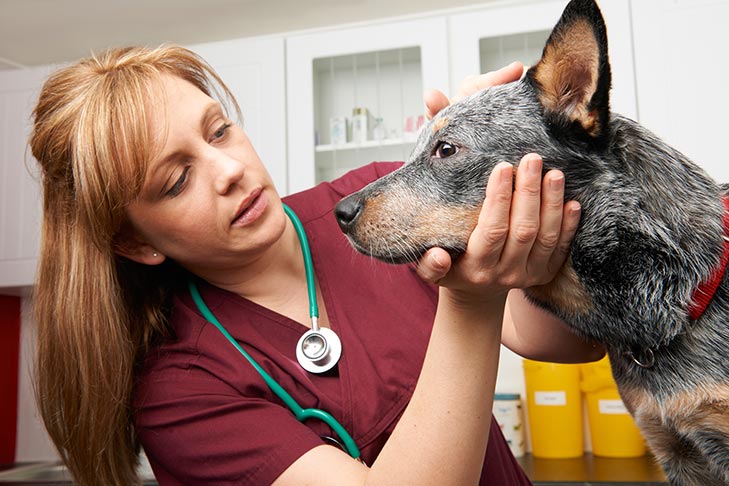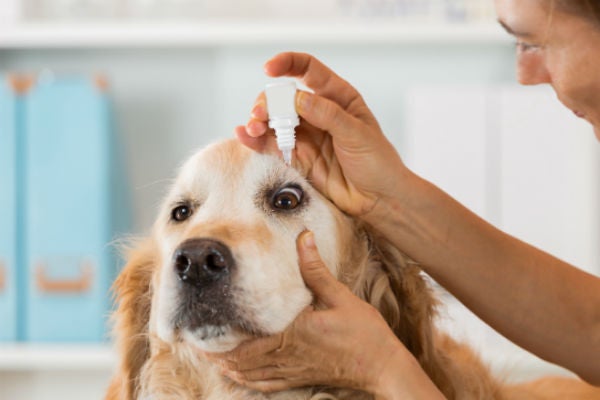Clubs Offering:
If the eyes are the windows to the soul, then it is no wonder we get worried when we notice cloudy eyes in dogs. After all, we don’t want our dogs to lose their vision or be uncomfortable.
When you see dogs with cloudy eyes, it may be a natural part of the aging process. But cloudy eyes in dogs can also can be a symptom of a number of eye problems. Trying to distinguish between what is normal and what is a problem can be tricky. While your veterinarian is your best source of information about your dog’s eye health, it helps to know what types of problems can cause a cloudy appearance in your dog’s eyes, and any other symptoms you can look out for.
The most common causes of cloudy eyes in senior dogs are nuclear sclerosis and cataracts. However, there are some other conditions that can also create a cloudy appearance in your dog’s eyes that require immediate veterinary attention.
As dogs age, some cloudiness is normal. “Most dogs, with age, develop a haze within the lens similar to cataracts, called nuclear sclerosis,” says veterinary ophthalmologist Martin Coster, DVM, MS, Diplomate of the American College of Veterinary Ophthalmologists (DACVO). “Unlike cataracts,” Coster says, “this condition rarely causes vision impairment. However, focusing ability may become impaired.”
It is easy to confuse cataracts and nuclear sclerosis. Both conditions cause the lens to appear cloudy, but there are a few differences. Nuclear sclerosis usually gives your dog’s eyes a cloudy, bluish discoloration, unlike cataracts, which are white and opaque.
More important, nuclear sclerosis (also called lenticular sclerosis) does not significantly diminish your dog’s vision the way cataracts do. It tends to affect both eyes at the same time. The two conditions look different when your veterinarian examines your dog’s eyes with an ophthalmoscope.
Nuclear sclerosis is a change in the lens of the eye that normally occurs with aging. There is no treatment needed because the condition does not cause serious problems, but it might be a good idea to discuss your dog’s aging eyes with your veterinarian, so that you know what to expect as your dog grows older.
“It is often common for dogs who have nuclear sclerosis to also develop cataracts,” says Dr. Jerry Klein, AKC chief veterinary officer. “If your dog develops nuclear sclerosis, your vet will want to conduct regular check-ups to look for cataracts.”
Dogs develop cataracts just like people do. These white, milky changes to your dog’s lens are the result of abnormal lens metabolism. The lens in both dog eyes and human eyes acts like a camera lens, focusing light on the film at the back of the eye, called the retina, where the brain then processes the information to form a picture of the world around it.
The lens is made up of water and protein. These materials are organized in a very specific way, and when the proteins start to clump together, either as the result of age or trauma, they can form cataracts. These protein strands gradually obscure the lens, making it harder for your dog to see and in some cases causing total blindness.
There are a variety of causes of cataracts in dogs, including age, trauma, metabolic diseases such as diabetes, and genetics.
Cataracts can obscure your dog’s vision. Sometimes they do not pose any additional problems beyond vision loss itself, but other times they can lead to an even more serious issue – glaucoma. “Prompt diagnosis is important. There is a surgical solution for cataracts, but it is best to do this as early in their formation as possible,” says Dr. Klein.

Glaucoma in dogs occurs when the pressure inside the eye increases, resulting in damage to the structures in the eye. This condition is painful, and very high intraocular (inside the eyes) pressure is considered a veterinary emergency, as it can lead to permanent damage to the optic nerve and vision loss.
A cloudy eye is not the only symptom of glaucoma. You may also notice that the white of the eye is red and irritated, or that there is a bulge to the eye, a blue or red tint to the cloudiness, increased discharge, squinting, a dilated pupil, and most alarmingly, loss of vision. Dogs are good at compensating for loss of vision in one eye by relying on the other eye, so it is often difficult to detect.
Glaucoma is usually diagnosed with a tool called a tonometer. “It’s important for your veterinarian or a veterinary ophthalmologist to determine whether a dog is suffering from primary or secondary glaucoma, because treatment may vary for each type,” says Dr. Klein. “Proper and prompt examination is also important because a dog with glaucoma in one eye is at high risk for getting glaucoma in the other eye.”
In cases where medication fails, your veterinarian may recommend laser therapy, eye removal, implants to facilitate drainage, gentamicin (an antibiotic) injections, and cyclocryotherapy (a procedure used to reduce the production of intraocular fluid.) In severe cases, a surgical procedure may be necessary to address the cause of the secondary glaucoma or to make your dog more comfortable.
Some cloudy eyes in dogs look like they have actual clouds in the lens, while others might look like there is something on the surface of your dog’s eye clouding it up. Severe cases of dry eye can lead to corneal ulceration and scarring, which falls into the second category.
Dry eye, or keratoconjunctivitis sicca, occurs when your dog’s body does not produce enough tears. Tears are necessary for lubrication and overall eye health, as the aqueous solution is how your dog’s eyes receive necessary nutrients. When your dog is not producing enough tears, the surface of her eyes becomes irritated. Ulcers can form, and in severe cases lead to perforation of the eye itself. In chronic cases of dry eye, the surface can scar, creating a cloudy, dull appearance.
Most cases of dry eye result from an abnormal reaction of the body’s immune system. Some breeds are more susceptible to dry eye than others, such as Yorkshire Terriers and Pugs.
There are other symptoms of dry eye besides cloudy eyes. These include mucous discharge, redness around the whites of the eye, swelling of the tissue on the surface of the eye and eyelids, and squinting or excessive blinking. Dry eye is often associated with an autoimmune inflammation of the tear glands and can be a chronic, lifelong condition. Diagnosis includes an eye exam and sometimes a test to measure the amount of tear production and moisture in the eye.
Luckily, dry eye can usually be treated with tear-stimulating medications and topical antibiotics, and in severe cases there are surgical options available to help promote increased tear production. “If diagnosed early, treated consistently, and monitored regularly by a veterinarian, dogs who have dry eye can be pain-free,” reports Dr. Klein.

Ulcers that form as a result of dry eye, trauma from rubbing the eye on a rough surface or being scratched by another animal, bacterial or viral infections, or other ophthalmic problems, like entropion (inward folding eyelids) or distichia (problematically placed hairs) can also create a cloudy appearance in your dog’s eye.
Ulcers are sores on your dog’s cornea (the membrane on the front of the eye). As they progress, they may appear bluish, reddish, or just as a haze on the surface of your dog’s eye. Like other serious eye problems, corneal ulcers can be painful and are often accompanied by discharge and squinting. If they become infected, they can lead to severe damage and even perforation.
To diagnose a corneal ulcer, the veterinarian will use a fluorescein stain test, and sometimes samples will be taken to be cultured. Ulcers are usually treated with medicated drops to prevent infection and relieve pain, and in severe cases may require surgery to save your dog’s eye, so it is best to get your dog to the veterinarian as soon as you notice signs of ocular discomfort, like squinting or rubbing at the eye with a paw.
Anterior uveitis can also cause a cloudy appearance in your dog’s eyes. The uvea refers to the part of the eye that is made up of the choroid, ciliary body, and iris — the tissue at the front of the eye. Anterior uveitis is inflammation of one or all of these structures, and it is a serious condition that can lead to irreversible vision loss.
Symptoms of anterior uveitis include redness, discharge, squinting, an oddly shaped pupil, eyeball swelling, excessive tearing, and a cloudy or dull appearance.
This painful condition can have a number of causes, including autoimmune disease, cancer, trauma, metabolic disease, parasites, and fungal, viral, and bacterial infections. Your veterinarian may run a series of diagnostic tests to narrow down the culprit. Treatment will depend on the cause, and could include eye drops, eye ointments, and oral medications.

Some dogs develop a condition called corneal dystrophy, which gives their cornea an opaque, cloudy appearance. This common condition is inherited, and is broken down into three types depending on the location in the eye: epithelial, stromal, and endothelial.
Epithelial corneal dystrophy affects the superficial layers of the cornea. This condition can be uncomfortable, and Shetland Sheepdogs appear to be the most susceptible breed.
Endothelial corneal dystrophy affects the deepest corneal layer. Dogs with this condition are typically middle-aged or older, and Boston Terriers. Chihuahuas, and Dachshunds are genetically predisposed. This type of dystrophy can lead to corneal ulcers.
The veterinarian will use a microscope with a bright light to identify the type of corneal dystrophy your dog has, as well as a fluorescein stain to examine the details of the eye, and may prescribe antibiotic eye medications. The appearance of cloudy eyes may continue. Both epithelial and endothelial cornea dystrophy can cause ulcers that require treatment, but there is no cure for corneal dystrophy. This condition usually does not lead to compromised vision.
Diagnosing and Treating Cloudy Eyes in Dogs
A veterinarian is the best person to diagnose the cause of your dog’s cloudy eyes, and your general practice doctor may refer you to a specialist in veterinary ophthalmology for further treatment.
The treatment for your dog’s cloudy eyes depends on the cause, the age of your dog, the progress of the problem, and your dog’s discomfort. Your veterinarian will lay out a plan to treat your dog’s cloudy eyes if treatment is necessary.
Watch your dog closely for other symptoms of eye problems, such as increased discharge, squinting, or a change in your dog’s eyes shape, size, color, or vision, and contact your veterinarian as soon as possible if you notice redness, squinting, or thick discharge from your dog’s eye, in addition to cloudiness. https://www.akc.org/wp-admin/admin-ajax.php Get Your Free AKC eBook
How Are Cataracts in Dogs Treated?
Cataract treatment for dogs generally involves surgical removal or physical dissolution (âbreaking upâ) of the cataract under anesthesia. The ideal time for cataract surgery is the immature or early mature cataract stage. Of course, your dog must also be in good general health to undergo treatment. For example, a diabetic dog must be well regulated before cataract surgery. Also, in order for a dog to be a good surgical candidate, they must also have a temperament conducive to having eye drops administered at home. Lab work is performed prior to anesthesia and some ophthalmologists also request that pets have their teeth cleaned prior to surgery to minimize sources of infection in the eye.
Historically, removing the cataract meant surgically cutting into the eye and physically removing the lens. This is still done for older patients whose lenses are compact, but for younger patients where the lens is still soft, a technique called phacoemulsification is preferred.Related article
That would be a cherry eye, and youâll want to see your vet.
Phacoemulsification has become the most common method of removing cataracts in dogs. With phacoemulsification, the lens is broken apart by sound waves and sucked out with a gadget similar to a tiny â a few millimeters wide â vacuum cleaner. Artificial lenses are implanted at the time of surgery, restoring essentially normal vision. (Without the artificial lens, the dogâs vision will be approximately 20/800, and objects will appear to be reversed, as in a mirror.)
Cataract surgery for dogs is performed routinely with an overall 80 to 90 percent success rate. Long term prognosis following cataract surgery is very good to excellent. Overall, a 95 percent vision rate is reported immediately after cataract surgery, and once cataracts are removed from a dogâs lens, they cannot return.
Cloudy Eyes in Dogs
During the first eight weeks of life, puppies are extremely dependent on their mother, because they need special care to grow healthy and strong. The mother will provide her puppies with the nutrition they need by nursing them until they are fully weaned and are less dependent on her to survive. During this period, puppies open their eyes for the first time, generally when they are between 10 and 14 days old.
Over these crucial first weeks, puppies grow out of infancy and learn to explore and play. They will begin to socialize with each other and with other members of their household once theyre physically able to do so. From interacting with their littermates to humans, the period of four to seven weeks is the ideal time to introduce your puppy to numerous people, as this helps the pup grow into an outgoing, friendly, and secure dog. Just be sure that anyone handling your young puppy knows to do so gently. 1:20